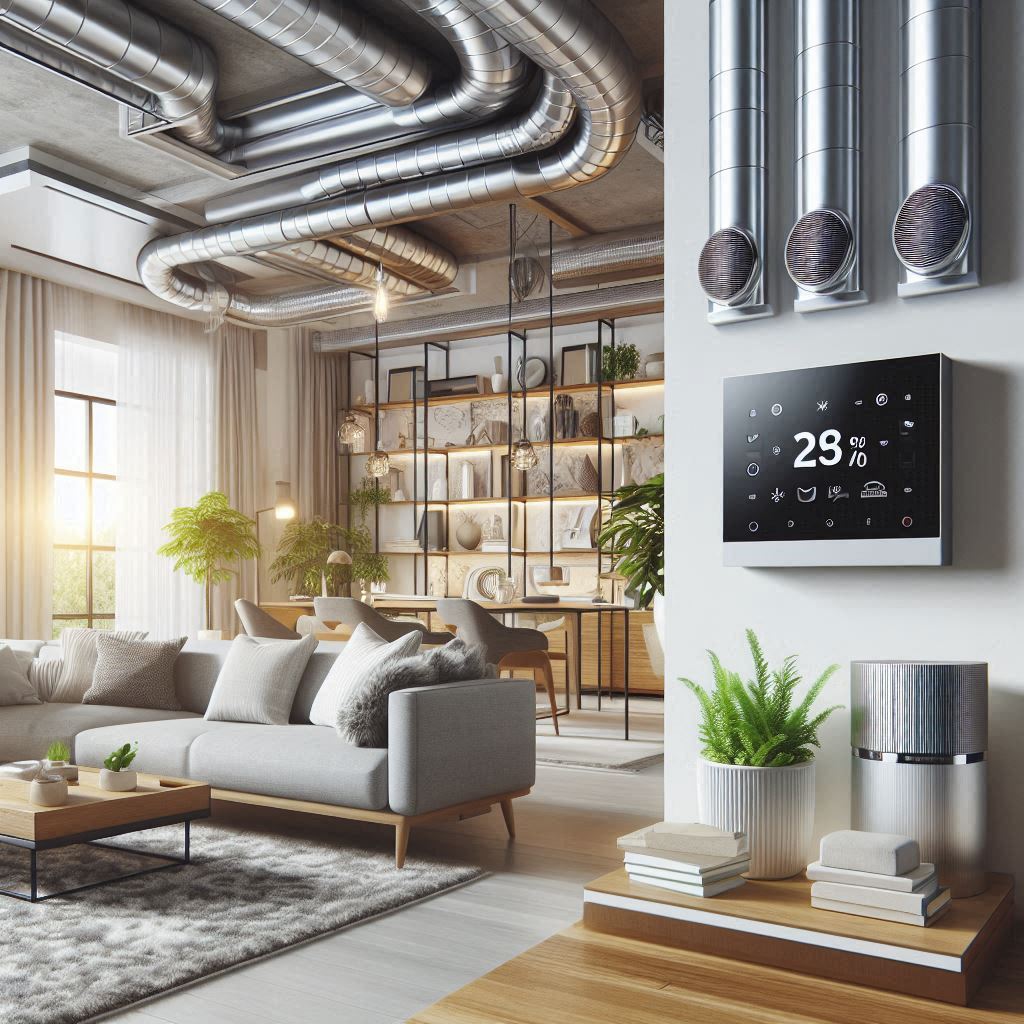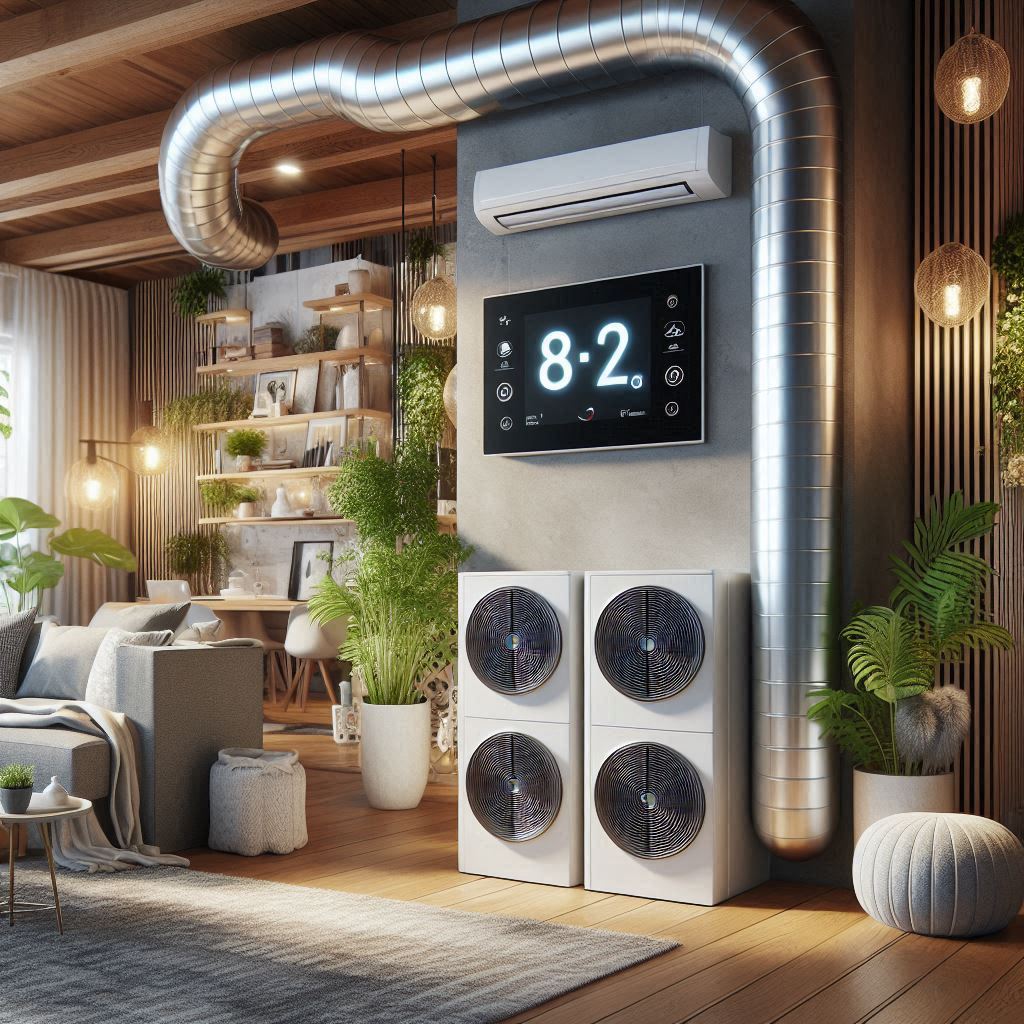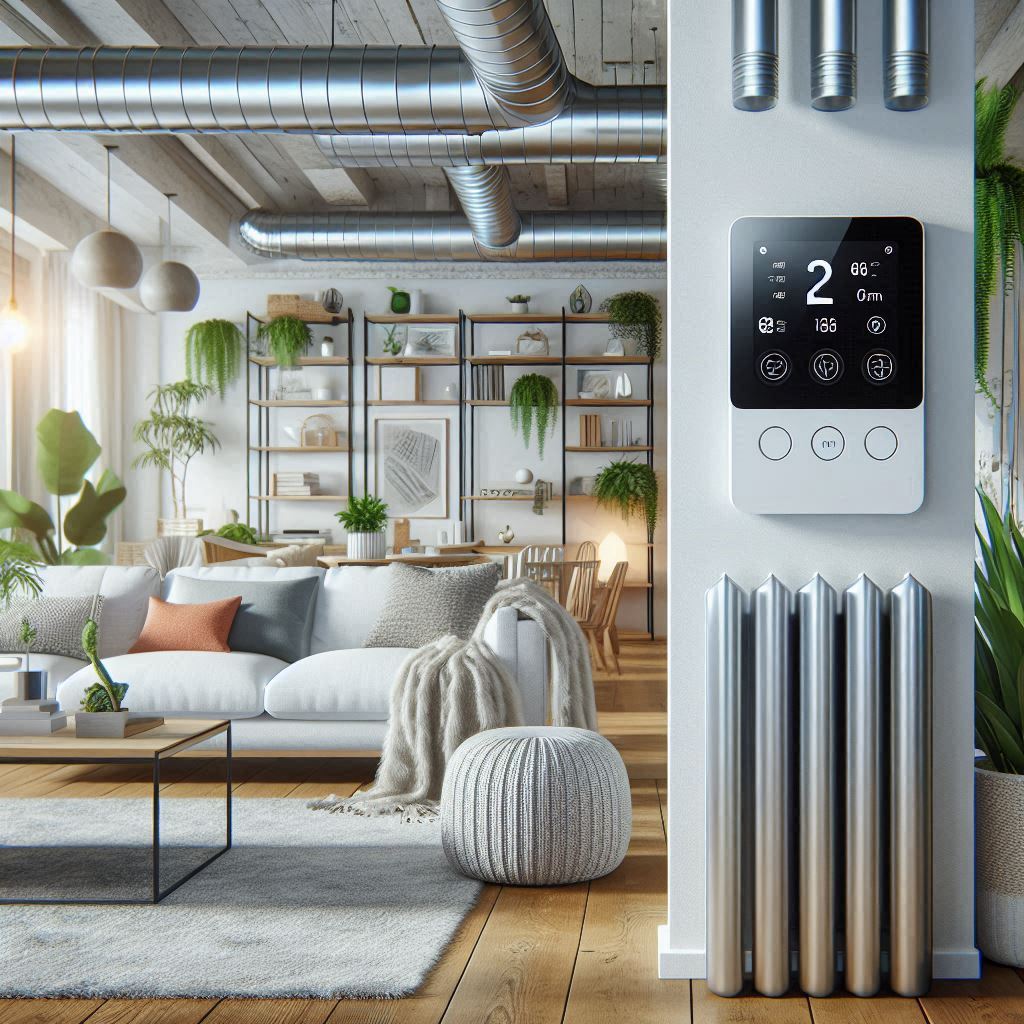The Future of USA HVAC System Industry is poised for transformative growth, driven by technological advancements, environmental concerns, and shifting consumer preferences. As the demand for efficient, sustainable, and smart heating, ventilation, and air conditioning (HVAC) systems rises, the industry is undergoing a significant evolution. This comprehensive exploration delves into the key trends, innovations, and market dynamics shaping the Future of USA HVAC System Industry, offering insights into how businesses and consumers can adapt to this rapidly changing landscape.
The global HVAC system market size is expected to be valued at USD 281.7 billion in 2024 and is projected to reach USD 389.9 billion by 2029, growing at a CAGR of 6.7% during the forecast period from 2024 to 2029.

Technological Advancements Shaping the Future of USA HVAC System Industry
Technology is at the heart of the Future of USA HVAC System Industry, revolutionizing how systems are designed, installed, and maintained. The integration of smart thermostats, Internet of Things (IoT) devices, and artificial intelligence (AI) is enhancing system efficiency and user experience. Smart HVAC systems allow homeowners and businesses to control temperature, humidity, and air quality remotely via smartphones, optimizing energy use and reducing costs. These systems can learn user preferences, adjust settings automatically, and provide real-time performance data, making them a cornerstone of the Future of USA HVAC System Industry.
IoT-enabled HVAC units are equipped with sensors that monitor system health, predict maintenance needs, and alert users to potential issues before they escalate. This predictive maintenance capability minimizes downtime and extends equipment lifespan, a critical factor in the Future of USA HVAC System Industry. AI algorithms further enhance system performance by analyzing data to optimize energy consumption, ensuring that HVAC units operate at peak efficiency. As these technologies become more accessible, their adoption is expected to drive significant growth in the Future of USA HVAC System Industry.
Another notable advancement is the development of variable refrigerant flow (VRF) systems, which offer precise temperature control and energy savings. VRF systems are gaining popularity in commercial buildings and high-end residential properties, contributing to the Future of USA HVAC System Industry by meeting the demand for flexible and efficient climate control solutions. These technological innovations are not only improving system performance but also aligning with the industry’s focus on sustainability and energy conservation.
Emphasis on Energy Efficiency and Sustainability in the Future of USA HVAC System Industry
Energy efficiency is a defining factor in the Future of USA HVAC System Industry, as consumers and regulators prioritize environmentally friendly solutions. HVAC systems account for a significant portion of energy consumption in residential and commercial buildings, making energy-efficient designs a top priority. The adoption of high-efficiency HVAC units, such as those with high Seasonal Energy Efficiency Ratio (SEER) ratings, is reducing energy costs and environmental impact, shaping the Future of USA HVAC System Industry.
Government regulations, such as the U.S. Department of Energy’s minimum efficiency standards, are pushing manufacturers to develop systems that consume less power while delivering superior performance. These regulations are driving innovation in the Future of USA HVAC System Industry, encouraging the use of eco-friendly refrigerants with lower global warming potential (GWP). For example, the transition from traditional refrigerants like R-410A to alternatives like R-32 is reducing the environmental footprint of HVAC systems, aligning with global sustainability goals.
Green building certifications, such as LEED (Leadership in Energy and Environmental Design), are also influencing the Future of USA HVAC System Industry. Buildings designed with energy-efficient HVAC systems are more likely to achieve these certifications, attracting environmentally conscious tenants and investors. Additionally, renewable energy integration, such as solar-powered HVAC units, is gaining traction, further enhancing the sustainability of the Future of USA HVAC System Industry. These efforts reflect a broader commitment to reducing carbon emissions and promoting a greener future.

Market Growth and Economic Drivers in the Future of USA HVAC System Industry
The Future of USA HVAC System Industry is supported by robust market growth, fueled by economic and demographic factors. The U.S. construction sector, particularly in the southern and western regions, is experiencing a boom in residential and commercial projects, increasing demand for HVAC systems. As urbanization accelerates and new buildings are constructed, the need for advanced climate control solutions is shaping the Future of USA HVAC System Industry.
Economic incentives, such as tax credits and rebates for energy-efficient HVAC installations, are encouraging consumers to upgrade their systems. These incentives are playing a pivotal role in the Future of USA HVAC System Industry, making advanced systems more affordable and accessible. Additionally, the rise of remote work and increased time spent indoors has heightened the importance of indoor air quality, further boosting demand for HVAC systems with advanced filtration and ventilation capabilities.
Impact of Indoor Air Quality on the Future of USA HVAC System Industry
Indoor air quality (IAQ) is a critical focus in the Future of USA HVAC System Industry, as consumers become more aware of its impact on health and well-being. Poor IAQ can lead to respiratory issues, allergies, and reduced productivity, prompting demand for HVAC systems with enhanced filtration and purification technologies. The COVID-19 pandemic amplified this trend, highlighting the importance of ventilation and air purification in preventing the spread of airborne pathogens.
Modern HVAC systems are equipped with high-efficiency particulate air (HEPA) filters, ultraviolet (UV) light purifiers, and ionization technologies to remove contaminants such as dust, pollen, and viruses. These advancements are shaping the Future of USA HVAC System Industry by addressing consumer concerns about health and safety. For commercial buildings, IAQ is a key factor in attracting tenants and ensuring compliance with workplace safety standards, further driving demand for advanced HVAC solutions.
The integration of IAQ monitoring systems is another emerging trend in the Future of USA HVAC System Industry. These systems provide real-time data on air quality parameters, such as particulate matter and volatile organic compounds (VOCs), enabling proactive adjustments to HVAC settings. By prioritizing IAQ, the Future of USA HVAC System Industry is aligning with broader public health goals and enhancing the value proposition of modern HVAC systems.

Smart Homes and the Future of USA HVAC System Industry
The rise of smart homes is a game-changer for the Future of USA HVAC System Industry, as consumers seek integrated solutions that enhance convenience and efficiency. Smart HVAC systems are compatible with home automation platforms like Amazon Alexa, Google Home, and Apple HomeKit, allowing seamless control of climate settings. This compatibility is driving adoption in the Future of USA HVAC System Industry, particularly among tech-savvy homeowners.
Smart HVAC systems offer features such as geofencing, which adjusts temperatures based on the user’s location, and energy usage reports, which help consumers track and reduce consumption. These features are making HVAC systems a central component of the smart home ecosystem, shaping the Future of USA HVAC System Industry. Additionally, the ability to integrate HVAC systems with other smart devices, such as lighting and security systems, is enhancing their appeal and functionality.
The growing popularity of smart homes is also influencing commercial HVAC applications, with building management systems (BMS) incorporating smart technology to optimize energy use and occupant comfort. As smart home adoption continues to rise, the Future of USA HVAC System Industry will see increased demand for systems that offer connectivity, automation, and user-friendly interfaces.
Download PDF Brochure for More Info @ https://www.marketsandmarkets.com/pdfdownloadNew.asp?id=202111288
Challenges Facing the Future of USA HVAC System Industry
While the Future of USA HVAC System Industry is promising, it faces several challenges that could impact growth and innovation. One significant challenge is the shortage of skilled HVAC technicians, which is limiting the industry’s ability to meet rising demand. Training programs and apprenticeships are being developed to address this issue, but the labor shortage remains a hurdle for the Future of USA HVAC System Industry.
Another challenge is the high upfront cost of advanced HVAC systems, which can deter consumers despite long-term energy savings. Manufacturers and policymakers are working to address this through financing options and incentives, but affordability remains a concern in the Future of USA HVAC System Industry. Additionally, the transition to low-GWP refrigerants requires significant investment in research and development, as well as retrofitting existing systems, posing logistical and financial challenges.
Supply chain disruptions, exacerbated by global events, have also affected the availability of HVAC components, leading to delays and increased costs. These disruptions are a critical consideration for the Future of USA HVAC System Industry, as they impact manufacturing and installation timelines. Addressing these challenges will require collaboration between industry stakeholders, policymakers, and educational institutions to ensure sustainable growth.
Emerging Trends in the Future of USA HVAC System Industry
Several emerging trends are shaping the Future of USA HVAC System Industry, offering new opportunities for innovation and market expansion. One such trend is the adoption of desiccant-enhanced evaporative (DEVAP) cooling systems, which use liquid desiccants and evaporative cooling to achieve energy-efficient climate control. These systems are particularly suited for humid climates, making them a promising solution in the Future of USA HVAC System Industry.
Another trend is the increasing use of modular HVAC systems, which offer flexibility and scalability for both residential and commercial applications. Modular systems can be customized to meet specific needs, reducing waste and improving efficiency, and are expected to play a significant role in the Future of USA HVAC System Industry. Additionally, the integration of blockchain technology for supply chain transparency and energy trading is an emerging area of interest, with potential to streamline operations and enhance sustainability.
The rise of subscription-based HVAC services is also gaining traction, allowing consumers to access maintenance, repairs, and upgrades through flexible payment plans. This model is enhancing customer engagement and loyalty, contributing to the Future of USA HVAC System Industry by creating new revenue streams for businesses. These trends highlight the industry’s ability to adapt to changing market dynamics and consumer expectations.
Consumer Behavior and Its Influence on the Future of USA HVAC System Industry
Consumer behavior is a driving force in the Future of USA HVAC System Industry, as preferences shift toward sustainability, convenience, and health-focused solutions. Eco-conscious consumers are prioritizing energy-efficient and environmentally friendly HVAC systems, influencing manufacturers to innovate and meet these demands. This shift is shaping the Future of USA HVAC System Industry by encouraging the development of green technologies and sustainable practices.
The demand for user-friendly interfaces and remote access is also influencing product design, with consumers favoring systems that offer seamless integration with smart devices. This trend is driving the Future of USA HVAC System Industry toward greater connectivity and automation, as manufacturers strive to deliver intuitive and accessible solutions. Additionally, heightened awareness of indoor air quality is prompting consumers to invest in systems with advanced filtration and purification features, further shaping market trends.
Digital platforms are playing a key role in consumer decision-making, with online reviews, social media, and search engines influencing purchasing behavior. HVAC companies are leveraging digital marketing and SEO strategies to reach these consumers, ensuring that their products and services are visible in the Future of USA HVAC System Industry. Understanding and adapting to these behavioral shifts is essential for businesses to remain competitive.
Policy and Regulation Impacting the Future of USA HVAC System Industry
Policy and regulation are critical drivers of the Future of USA HVAC System Industry, as governments seek to address climate change and energy consumption. Federal and state regulations, such as the Energy Policy Act and regional efficiency standards, are setting benchmarks for HVAC performance and emissions. These regulations are shaping the Future of USA HVAC System Industry by encouraging innovation and compliance with environmental goals.
Incentives like the Inflation Reduction Act provide financial support for consumers and businesses adopting energy-efficient HVAC systems, boosting market demand. These policies are a key factor in the Future of USA HVAC System Industry, making advanced systems more accessible and driving adoption. Additionally, international agreements, such as the Kigali Amendment to the Montreal Protocol, are influencing the phase-down of high-GWP refrigerants, further shaping industry practices.
Local building codes and standards are also impacting the Future of USA HVAC System Industry, as municipalities enforce requirements for energy efficiency and indoor air quality. Compliance with these regulations is essential for manufacturers and contractors, ensuring that systems meet the evolving needs of the market. The interplay of policy and innovation is creating a dynamic environment for the Future of USA HVAC System Industry.
Future Outlook for the USA HVAC System Industry
The Future of USA HVAC System Industry is bright, with opportunities for growth, innovation, and sustainability. As technology continues to advance, HVAC systems will become more efficient, connected, and user-friendly, meeting the needs of a diverse consumer base. The focus on energy efficiency and indoor air quality will drive demand for advanced systems, while economic and regulatory factors will support market expansion.
Collaboration between industry stakeholders, including manufacturers, contractors, and policymakers, will be essential to address challenges and capitalize on opportunities. Investments in workforce development, supply chain resilience, and research and development will ensure that the Future of USA HVAC System Industry remains competitive and innovative. By embracing these trends and adapting to changing market dynamics, the industry is well-positioned to thrive in the years ahead.
In conclusion, the Future of USA HVAC System Industry is defined by its ability to innovate and adapt to a rapidly changing world. From smart technology and energy efficiency to indoor air quality and consumer behavior, the industry is evolving to meet the demands of the modern era. Businesses that prioritize sustainability, leverage technology, and align with regulatory and consumer trends will lead the way in shaping the Future of USA HVAC System Industry, creating a more comfortable, efficient, and environmentally friendly future for all.
Frequently Asked Questions (FAQs)
What is driving the Future of USA HVAC System Industry?
The Future of USA HVAC System Industry is driven by technological advancements, energy efficiency regulations, consumer demand for smart systems, and growing awareness of indoor air quality.
How are smart HVAC systems shaping the Future of USA HVAC System Industry?
Smart HVAC systems, with features like remote control, IoT connectivity, and predictive maintenance, are enhancing efficiency and user experience, making them a key component of the Future of USA HVAC System Industry.
What role does energy efficiency play in the Future of USA HVAC System Industry?
Energy efficiency is central to the Future of USA HVAC System Industry, with high-SEER systems, eco-friendly refrigerants, and renewable energy integration reducing costs and environmental impact.
How is indoor air quality influencing the Future of USA HVAC System Industry?
Increased focus on indoor air quality is driving demand for HVAC systems with advanced filtration and purification technologies, shaping the Future of USA HVAC System Industry by prioritizing health and safety.
What challenges does the Future of USA HVAC System Industry face?
The Future of USA HVAC System Industry faces challenges such as labor shortages, high system costs, supply chain disruptions, and the transition to low-GWP refrigerants, requiring strategic solutions for sustained growth.